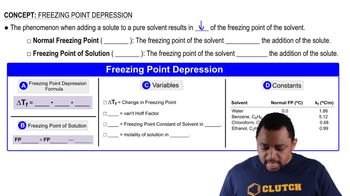Find the mass of urea (CH4N2O) needed to prepare 50.0 g of a solution in water in which the mole fraction of urea is 0.0770.
Ch.14 - Solutions

Chapter 14, Problem 121
A solution contains 10.05 g of unknown compound dissolved in 50.0 mL of water. (Assume a density of 1.00 g/mL for water.) The freezing point of the solution is -3.16 °C. The mass percent composition of the compound is 60.97% C, 11.94% H, and the rest is O. What is the molecular formula of the compound?
 Verified step by step guidance
Verified step by step guidance1
Calculate the molality of the solution using the freezing point depression formula: \( \Delta T_f = i \cdot K_f \cdot m \), where \( \Delta T_f \) is the change in freezing point, \( i \) is the van't Hoff factor (assume 1 for non-electrolytes), \( K_f \) is the freezing point depression constant for water (1.86 °C kg/mol), and \( m \) is the molality.
Determine the moles of solute using the molality and the mass of the solvent (water). Since the density of water is 1.00 g/mL, 50.0 mL of water is 50.0 g, which is 0.0500 kg.
Calculate the molar mass of the unknown compound by dividing the mass of the compound (10.05 g) by the moles of solute obtained in the previous step.
Use the mass percent composition to determine the empirical formula. Assume 100 g of the compound, which gives 60.97 g of C, 11.94 g of H, and the remainder as O. Convert these masses to moles by dividing by their respective atomic masses (C: 12.01 g/mol, H: 1.008 g/mol, O: 16.00 g/mol).
Determine the simplest whole number ratio of moles of C, H, and O to find the empirical formula. Then, compare the empirical formula mass to the molar mass to find the molecular formula.

Verified video answer for a similar problem:
This video solution was recommended by our tutors as helpful for the problem above.
Video duration:
8mWas this helpful?
Key Concepts
Here are the essential concepts you must grasp in order to answer the question correctly.
Freezing Point Depression
Freezing point depression is a colligative property that describes how the freezing point of a solvent decreases when a solute is added. The extent of this depression depends on the number of solute particles in the solution, not their identity. The formula used to calculate the change in freezing point is ΔTf = i * Kf * m, where i is the van 't Hoff factor, Kf is the freezing point depression constant, and m is the molality of the solution.
Recommended video:
Guided course

Freezing Point Depression
Molar Mass and Molecular Formula
The molar mass of a compound is the mass of one mole of its entities, typically expressed in grams per mole. To determine the molecular formula, one must first find the empirical formula based on the mass percent composition of the elements. The empirical formula is then multiplied by a whole number to match the molar mass of the compound, allowing for the determination of the actual molecular formula.
Recommended video:
Guided course

Molar Mass Concept
Mass Percent Composition
Mass percent composition is a way to express the percentage by mass of each element in a compound. It is calculated by dividing the mass of each element in one mole of the compound by the total molar mass of the compound and multiplying by 100. This information is crucial for determining the empirical formula and ultimately the molecular formula of the unknown compound in the question.
Recommended video:
Guided course

Mass Percent Calculation
Related Practice
Textbook Question
Textbook Question
The osmotic pressure of a solution containing 2.10 g of an unknown compound dissolved in 175.0 mL of solution at 25 °C is 1.93 atm. The combustion of 24.02 g of the unknown compound produced 28.16 g CO2 and 8.64 g H2O. What is the molecular formula of the compound (which contains only carbon, hydrogen, and oxygen)?
Textbook Question
A 100.0-mL aqueous sodium chloride solution is 13.5% NaCl by mass and has a density of 1.12 g/mL. What would you add (solute or solvent) and what mass of it to make the boiling point of the solution 104.4 °C? (Use i = 1.8 for NaCl.)
Textbook Question
A 50.0-mL solution is initially 1.55% MgCl2 by mass and has a density of 1.05 g/mL. What is the freezing point of the solution after you add an additional 1.35 g MgCl2? (Use i = 2.5 for MgCl2.)
